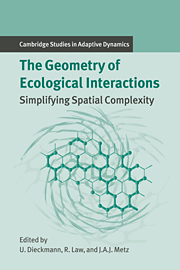Book contents
- Frontmatter
- Contents
- Contributing Authors
- 1 Introduction
- Part A Empirical and Statistical Background: A Plant Ecological Perspective
- Part B When the Mean-field Approximation Breaks Down
- Part C Simplifying Spatial Complexity: Examples
- Part D Simplifying Spatial Complexity: Techniques
- Introduction to Part D
- 18 Pair Approximations for Lattice-based Ecological Models
- 19 Pair Approximations for Different Spatial Geometries
- 20 Moment Methods for Ecological Processes in Continuous Space
- 21 Relaxation Projections and the Method of Moments
- 22 Methods for Reaction–Diffusion Models
- 23 The Dynamics of Invasion Waves
- 24 Epilogue
- References
- Index
- International Institute for Applied Systems Analysis
19 - Pair Approximations for Different Spatial Geometries
Published online by Cambridge University Press: 14 January 2010
- Frontmatter
- Contents
- Contributing Authors
- 1 Introduction
- Part A Empirical and Statistical Background: A Plant Ecological Perspective
- Part B When the Mean-field Approximation Breaks Down
- Part C Simplifying Spatial Complexity: Examples
- Part D Simplifying Spatial Complexity: Techniques
- Introduction to Part D
- 18 Pair Approximations for Lattice-based Ecological Models
- 19 Pair Approximations for Different Spatial Geometries
- 20 Moment Methods for Ecological Processes in Continuous Space
- 21 Relaxation Projections and the Method of Moments
- 22 Methods for Reaction–Diffusion Models
- 23 The Dynamics of Invasion Waves
- 24 Epilogue
- References
- Index
- International Institute for Applied Systems Analysis
Summary
Introduction
The standard assumption underlying the formulation of models for population dynamics (such as the logistic growth equation, the Lotka–Volterra predator–prey model, and the Kermack and McKendrick epidemiological equations, to name a few) is that populations spread homogeneously through space and that individuals mix rapidly. It is not a new insight that spatial structure is often an essential component of the ecological (and evolutionary) dynamics of populations, and there have been many approaches to understanding the various consequences of spatial structure. In this chapter I address one of the more recently developed techniques for modeling spatial population dynamics.
The oldest approach is to assume that populations are subdivided into different discrete subpopulations that are linked through migration (the “metapopulation” approach). This may be a reasonable assumption for certain systems (groups of parasites living in different hosts, for example), but space often has a more a continuous aspect. For example, a forest may be highly structured without having clear boundaries between subpopulations. Such situations are often modeled using a diffusion formalism, but this approach has its shortcomings as well. In particular, when one considers spatial spread of a population (or gene), individuality (discreteness) and its associated stochasticity may be important (Durrett and Levin 1994b). In a diffusion model, the rate of population growth is determined by the spread of “nano-individuals” at the wave front, whereas in reality it is often determined by the more erratic process of dispersal and subsequent successful settlement of individuals.
- Type
- Chapter
- Information
- The Geometry of Ecological InteractionsSimplifying Spatial Complexity, pp. 359 - 387Publisher: Cambridge University PressPrint publication year: 2000
- 46
- Cited by



